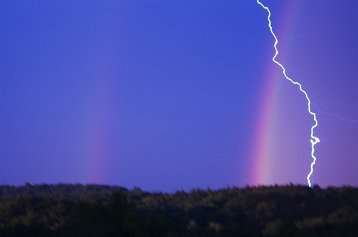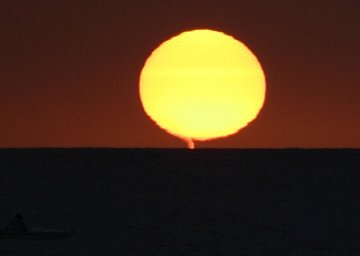 Discovery and the ISS are orbiting Earth. Would you like to see them? Sign up for Spaceweather PHONE.
Discovery and the ISS are orbiting Earth. Would you like to see them? Sign up for Spaceweather PHONE.
NLC ALERT: Much of Europe is experiencing a vivid sunset display of noctilucent clouds. As the day-night divide sweeps west toward North America, sky watchers in Canada might see these clouds, too. Look west at sunset!
DISTURBING THE PEACE: You don't see this every day--a peaceful rainbow split down the middle by a bolt of lightning:

On June 28th, Julie Juratic took the picture as a thunderstorm was winding down over the Cuyahoga Valley National Park in Ohio.
Although we seldom see them together, rainbows and lightning are related. Both are created by rain. Raindrops make rainbows by catching the rays of the sun and spreading them into their underlying colors. Raindrops make lightning by rubbing against ice crystals in thunderclouds. Like socks rubbing against carpet, raindrops rubbing against ice crystals create an electrical charge and--zap!--lightning.
more images: from George Varros of Mount Airy, Maryland.
STRANGE SUNSET: "I was watching the sun set from the Kona coast of Hawaii," reports Julie Deth-Rhoden Hutto, "when the sun touched the ocean in a unique fashion: the light started at the ocean and worked its way up to the sun, like a bright string. I've seen many solar illusions; this one was pretty cool and very different."

Andrew Young, an authority on mirages, believes he knows what happened: "The odd-looking link between the sea and sun was produced by refraction of the sun's rays through a thermal convective vortex--a swirling column of air over the open ocean." By itself, the vortex was invisible. "It was too weak for internal condensation or entrained water." But when the sunlight hit it just right--wow!
Extra: Weather photographer Harald Edens suggests an alternate explanation: hot gases rising from the smokestack from a distant ship. "These gases could create the same refraction effect [as an ocean vortex]," says Edens, "but it would not be such a rare occurrence."

